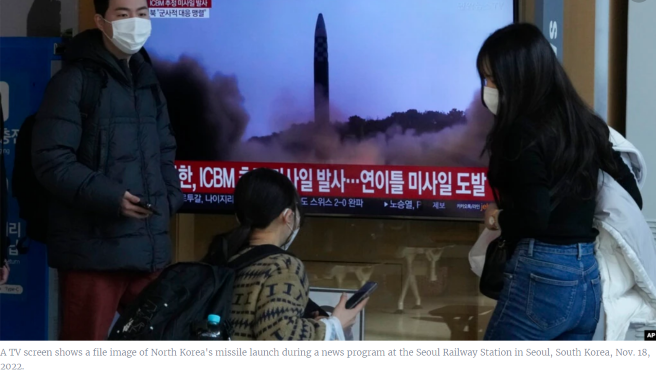North Korean ICBM Lands in Japan’s EEZ

William Gallo
SEOUL, SOUTH KOREA — A day after warning of more aggressive steps in response to increased military activity by the United States and its allies, North Korea on Friday fired an intercontinental ballistic missile that apparently prompted a U.S.-Japanese air base to issue a seek cover order.
The North Korean ICBM flew for more than an hour before splashing down in Japan’s exclusive economic zone – in waters about 200 kilometers west of Hokkaido prefecture in northern Japan – according to Japanese officials.
On its Facebook page, the Misawa Air Base, a joint U.S.-Japanese military facility on the northern island of Honshu, said authorities issued a seek cover order as a precautionary measure, without mentioning the North Korean missile.
In response, the United States and its ally South Korea held joint air drills that included F-35A fighter jets conducting laser-guided strikes, according to South Korea’s National Defense Ministry.
In Washington, the National Security Council condemned the launch as a “brazen violation of multiple UN Security Council resolutions [that] needlessly raises tensions and risks destabilizing the security situation in the region.”
South Korea’s military said the incident is a “significant provocation and serious act of threat that undermines peace and stability” in Korea and the wider region.
Japanese Prime Minister Fumio Kishida said his country lodged a “strong protest” against North Korea, which he said has “repeated its provocations with unprecedented frequency.”
“We absolutely cannot tolerate these actions,” Kishida told reporters in Thailand, where he is attending a regional summit.
Japanese Defense Minister Yasukazu Hamada said the missile had the range to reach the U.S. mainland, adding it was capable of flying 15,000 kilometers.
South Korea’s Yonhap news agency said the launch likely involved North Korea’s largest missile – the Hwasong-17 ICBM, which some experts have dubbed the “monster missile.”
The launch comes a day after North Korean Foreign Minister Choe Son Hui vowed a “fiercer” action against the United States, Japan, and South Korea.
Choe’s statement particularly took aim at a recent summit during which U.S., Japanese, and South Korean leaders agreed to cooperate more closely on deterring North Korea.
“Pyongyang is trying to disrupt international cooperation against it by escalating military tensions and suggesting it has the capability of holding American cities at risk of nuclear attack,” said Leif-Eric Easley, a professor at Ewha University in Seoul.
North Korea has developed multiple types of ICBMs that are believed to be capable of reaching the United States. Analysts say continued testing is necessary to ensure the missiles meet technical specifications, including the ability to survive reentry into the atmosphere.
North Korea is banned from conducting ballistic missile tests of any range under multiple U.N. Security Council resolutions.
In recent weeks, North Korea has unleashed an unprecedented barrage of missiles, including some that have prompted air raid sirens and shelter warnings in Japan and South Korea.
North Korea says it is a response to the increased military exercises by the United States and its allies. Washington says the drills are necessary as a response to the North Korean tests.
It is the second consecutive day that North Korea has launched a ballistic missile. On Thursday, just hours after Choe’s statement was released, North Korea launched a short-range ballistic missile that landed in the sea off its east coast.
North Korea has launched more than 70 ballistic missiles this year – by far a record – including multiple ICBMs.
The North’s latest launch occurred as many world leaders were gathered in Thailand for an Asia-Pacific Economic Cooperation summit.
U.S. Vice President Kamala Harris, who is leading the U.S. delegation at the APEC summit, convened an emergency meeting that included leaders from South Korea, Japan, Australia, Canada, and New Zealand.
Afterward, she said the leaders “strongly condemn[ed]” the launch, which “destabilizes security in the region and unnecessarily raises tensions.”
